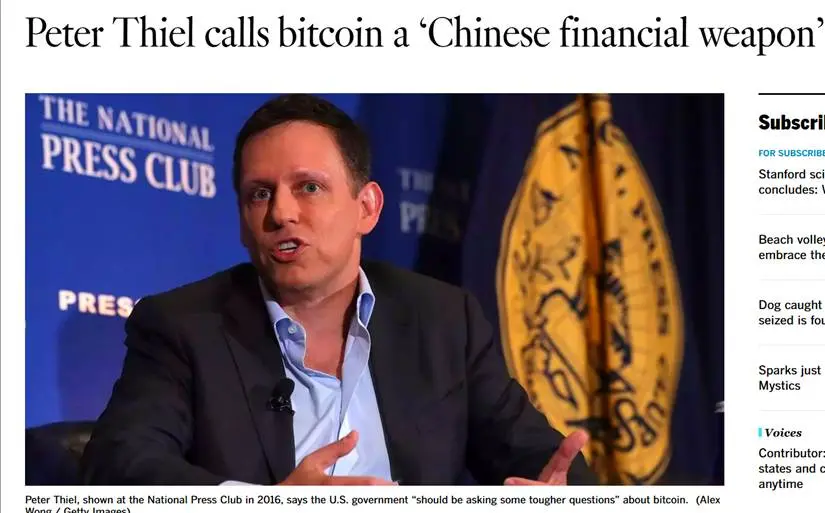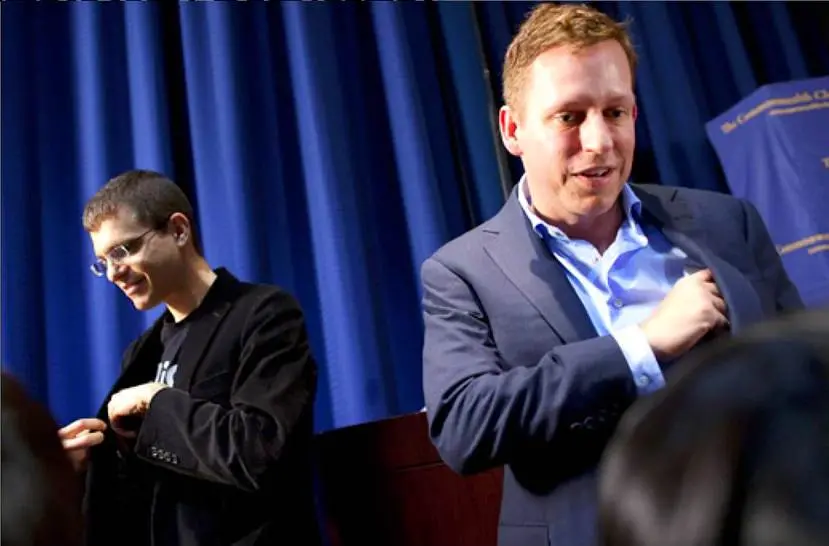BitMine stock price skyrockets: Peter Thiel, the godfather of Silicon Valley venture capital, gambles on Ethereum
Author: Zz, ChainCatcher
Edited by TB, ChainCatcher
In July 2025, an SEC filing detonated the crypto circle: Peter Thiel's entity quietly took a 9.1% stake in BitMine Immersion Technologies, becoming the largest investor in the Ethereum vault. As soon as the news came out, BitMine's stock price soared in response, hitting an intraday high of 29.3%.
X platform exploded: PayPal's gangster godfather finally attacked Ethereum, Peter Thiel switched from Bitcoin? Is this to replicate MicroStrategy's gameplay?
It is not for nothing that the market is so restless. Just a year ago, Peter Thiel was publicly questioning Bitcoin: we already have ETFs, and I don't know who else will buy them. When the institutional army has entered, who can push the next wave? From Bitcoin to Ethereum, what is the next game of chess for this Silicon Valley billionaire?
Holding $1 billion worth of ETH outside of ambition
BitMine's ambition is unabashed: to become the Ethereum version of MicroStrategy. On July 14, 2025, BitMine held $500 million worth of Ethereum (163,142 ETH). Three days later, that number doubled to $1 billion, 300,657 ETH. Even in the crypto world, this accumulation rate is insane.
But Peter Thiel has more than just another corporate vault. In 2023, a move by Founders Fund exposed his investment territory: investing $200 million in Bitcoin and Ethereum, each accounting for half. This configuration itself is a signal that Ethereum is already on par with Bitcoin.
In addition to BitMine's heavy blow, Peter Thiel's layout in the Ethereum ecosystem has already been quietly unfolded:
Trading infrastructure: Invested in the Bullish exchange in 2021, with Peter Thiel as a senior advisor.
Compliance infrastructure: Invest in Paxos (a regulated stablecoin issuer) in 2024, continue to increase in 2025, participate in Ubyx, and become Visa in the stablecoin field.
DeFi infrastructure: Led investment in Avantis in June 2025, specializing in on-chain derivatives.
Layer-2 Scaling: Invest in Caldera. When mainnet gas fees remain high, Layer-2 is the key to making DeFi truly usable.
Bitcoin is digital gold, and Ethereum is the new financial market. An investor close to Founders Fund revealed that it is enough to store value to buy Bitcoin. But to control the future financial infrastructure, you need Ethereum.
This judgment is well-founded. When Bitcoin is still struggling with stored value vs. payment, Ethereum has become the main battlefield of DeFi (with a lock-up value of more than $100 billion), the preferred platform for stablecoins (USDT, USDC mainly circulates on Ethereum), and the basic layer of RWA (real-world assets) tokenization.
More importantly, Ethereum can earn interest. This is something Bitcoin can't do. BitMine's Ethereum vault strategy is aimed at exactly this, allowing assets to generate cash flow.
Peter Thiel's ambitions don't stop there: the Bullish exchange secretly filed an IPO (June 2025), supported the creation of Erebor Bank (plans to hold stablecoins) dedicated to crypto businesses, through CoinDeskControl the right to speak in the industry. The picture is clear: he is no longer content with holding assets, but wants to control the channels of asset flow.
The proportion of the Ethereum ecosystem in the Founders Fund's blockchain portfolio is also gradually rising. If 2014-2022 was Peter Thiel's Bitcoin era, focusing on store of value and ideological narratives, then after 2023, he officially entered the Ethereum era and built a practical financial infrastructure.
Bitcoin wins the war of ideas, but Ethereum will win practical applications. When central bank digital currencies, corporate stablecoins, tokenized securities become a reality, they will all run on Ethereum.
Peter Thiel holds BitMine shares across various entities, not just investing, but preparing for control. If BitMine becomes the largest corporate Ethereum holder, Peter Thiel will effectively become the shadow central bank of the Ethereum ecosystem. From PayPal to Bitcoin to Ethereum, Peter Thiel's dream of a financial empire has never changed, but the tools are constantly evolving.
The dominant Founders Fund started taking positions when Bitcoin reached $1,000
While Bitcoin was still hovering around $1,000, the Founders Fund had already started taking positions. According to insiders, the first batch of investments amounted to tens of millions of dollars, which was aggressive among institutional investors at the time.
But Peter Thiel's ambitions don't stop there. In 2013, he invested in Block.one (later developing EOS). While EOS ultimately failed to shake up Ethereum, the investment revealed his true intentions: he wanted not Bitcoin itself, but the next Bitcoin.
What is even more intriguing is his layout path:
Mining side: Investing in BitMine in 2025 is just the latest move. As early as 2018, it participated in Layer1 financing.
Trading side: Before Bullish, he was an early investor in Kraken. Compared to Coinbase's compliance route, Kraken maintains a more cypherpunk style, which is very Peter Thiel.
Infrastructure: In 2021, when everyone was chasing DeFi tokens, Founders Fund quietly invested in Voltage to provide infrastructure for the Bitcoin Lightning Network.
Peter Thiel's understanding of Bitcoin is much more than digital gold. In April 2021, he threw out the view in a conversation with former Secretary of State Pompeo: Bitcoin could be a financial weapon used by China to weaken the dollar.

The currency circle was in an uproar. Supporters call him a traitor, opponents say he is a conspiracy theory. However, placing this passage in Peter Thiel's overall system of thought, the logic becomes clear: Bitcoin is not only an investment product, but also a geopolitical tool. It can take the initiative in the new financial war.
Interestingly, just a year later, he changed the tone at the Bitcoin conference, describing it as a revolutionary weapon against the politics of financial geria. He even made a list of enemies: Buffett, BlackRock's Larry Fink, JPMorgan's Jamie Dimon.
In the face of conservatives, he talks about national security. Facing the crypto community, he talks about the liberal revolution. What remains unchanged is the core goal: to promote a new order independent of the traditional financial system. This is exactly the core trait of Peter Thiel: using narrative as a weapon.
Its results are remarkable: in 2022, it liquidated its position in time before the crypto winter, making a profit of $1.8 billion; In 2023, when Bitcoin fell to $30,000, he shot again and bought $100 million. Textbook-level high throw and low suck.
An interesting detail: In July 2024, when the Bitcoin ETF was launched and institutional funds entered the market in droves, Peter Thiel publicly stated that he was not sure that it would see a big increase from here. The real weapon will never be an ETF that everyone can buy.
Behind all the layouts is an unfinished monetary dream
Looking at the investment portfolio of the Founders Fund, the rules are clear: almost no DApps, no GameFi, and no taste of NFT. What I am really interested in is: Layer2 scaling solution (Caldera), compliance infrastructure (Paxos), derivatives protocol (Avantis), stablecoin network (Ubyx). Protocol is better than product, this is Peter Thiel's credo.
Back in 1998, when 23-year-old Peter Thiel and Max Levchin founded PayPal, what was their original vision? Not to make a payment instrument, but to create a new form of money.

A decade before the birth of Bitcoin, Peter Thiel was thinking about how to disrupt the monetary system. PayPal even developed the PalmPilot app early on, which can transfer digital cash over infrared rays. In the end, due to regulatory pressure, it had to transform into a traditional payment company.
In 2002, eBay acquired PayPal for $1.5 billion. Peter Thiel's first thing after cashing out: founded Clarium Capital and systematically looked for the next monetary revolution opportunity. He waited 12 years.
In 2014, when Peter Thiel first seriously studied Bitcoin, he saw not electronic cash, but PayPal's unfulfilled dream. We live in a world where bits are unregulated and atoms are regulated. In 2015, Peter Thiel summed it up. The subtext is: in the digital world, you can build anything, including a whole new financial system.
In "From 0 to 1", Peter Thiel repeatedly emphasizes that competition is a loser's game, and monopoly can bring excess profits. PayPal's experience taught him that it is almost impossible to establish a financial monopoly in the traditional world. Regulation will kill you, and big banks will encircle you. Cryptocurrencies are a game-changer.
How to build a monopoly in a decentralized world? The answer is: control the infrastructure at the bottom. When everyone is building on Ethereum, owning Ethereum is collecting rent. When stablecoins are required for all transactions, controlling the stablecoin protocol is equivalent to printing money. When regulation finally arrives, having a compliance license is equivalent to having a ticket to the entrance.
Peter Thiel even funded key figures in this revolution, and in 2014, his Peter Thiel Fellowship gave 19-year-old Vitalik Buterin $100,000, leading him to decide to drop out of the University of Waterloo to develop Ethereum full-time. In a sense, Peter Thiel not only invests in infrastructure, he also invests in the people who build it.
This explains why Peter Thiel is a winner no matter which path he takes in the future, regardless of which path he takes. The deeper reason may be that in his view, cryptocurrency is not PayPal 2.0, but what PayPal is supposed to be, a truly free global financial system that is not controlled by any government.
Now, Peter Thiel's crypto empire has taken shape
Peter Thiel in 2025 is no longer satisfied with being a passive coin holder. With BitMine, Bullish, Erebor, he is building a whole crypto finance empire.
Writing this, a question arises: why is Peter Thiel so aggressive when the traditional financial giants are still on the sidelines? Perhaps the answer lies in his 2015 quote: We live in a world where bits are unregulated and atoms are regulated.
For Peter Thiel, cryptocurrencies are not just a financial revolution but the ultimate tool for building an unregulated world of bits. Now, it's time to place your bets.
After all, as his good friend and Tesla CEO Elon Musk said: the best adventures are calculated adventures. In the ultimate adventure of cryptocurrency, Peter Thiel's calculations, have just begun.
Recommended reading:
Peter Thiel joins forces with Trump's "financiers" to enter the game: crypto giants and Silicon Valley tycoons grab crypto banks on both fronts
The price is strong, and the four main "buys" of ETH are sorted out in one article
